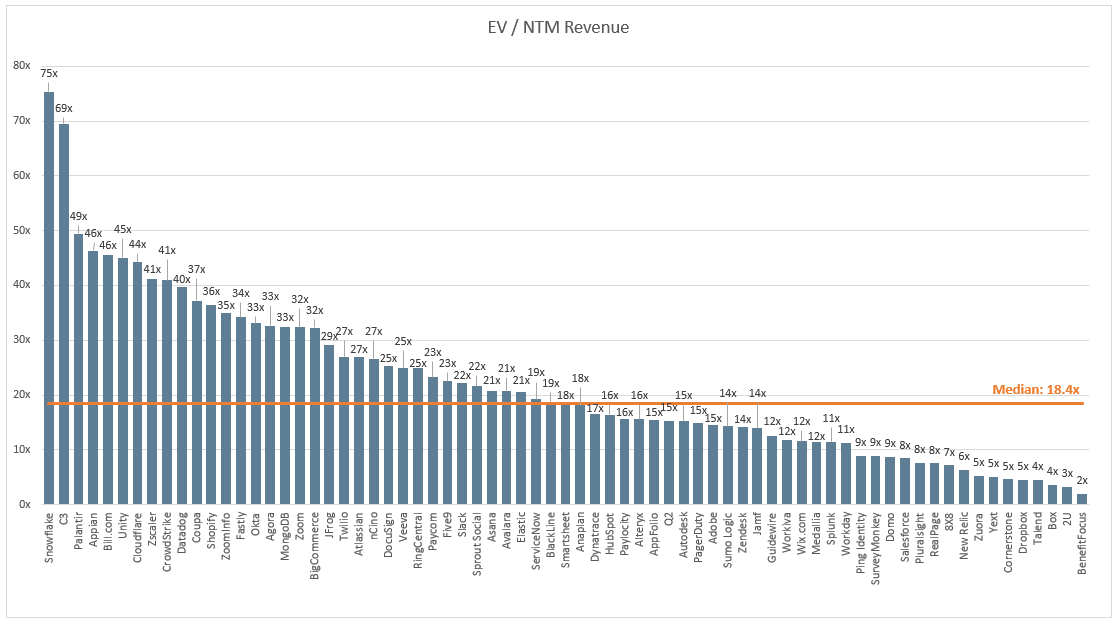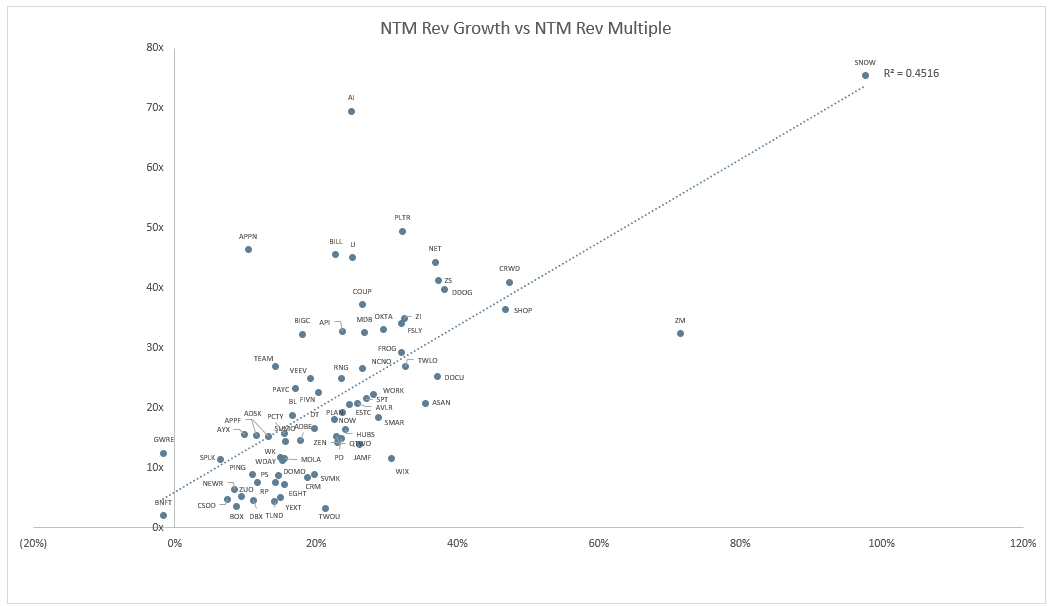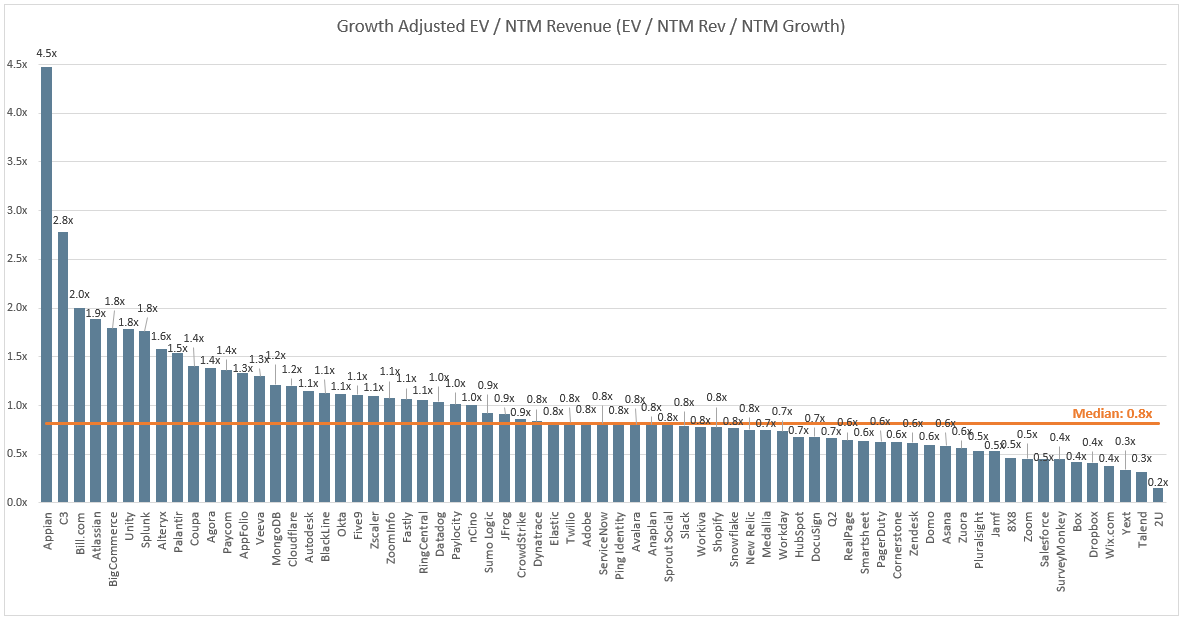Clouded Judgement 1.29.21
Every week I’ll provide updates on the latest trends in SaaS valuations, earnings announcements, and highlight any significant news. Follow along to stay up to date!
Highlight of the Week - Azure Growth Accelerating
This week Microsoft reported earnings, and their Azure line of business preformed quite well. They don’t disclose revenue figures for Azure alone (it’s instead lumped into its Intelligent Cloud business segment), but they’re estimated to be ~$7B for the quarter (of the $14.6B Intelligent Cloud total rev). This puts Azure at roughly a $28B-$30B run rate. Year-over-year growth for Azure this quarter was 48%, which is up from 47% YoY growth last quarter. Growing this quickly at such a massive scale is amazing. And accelerating growth at that scale is even more impressive. Just another data point / reminder of how big these cloud markets are.
Earnings Summary
Top 10 EV / NTM Revenue Multiples
Top 10 Weekly Share Price Movement
Update on Multiples
SaaS businesses are valued on a multiple of their revenue - in most cases the projected revenue for the next 12 months. Multiples shown below are calculated by taking the Enterprise Value (market cap + debt - cash) / NTM revenue. In the buckets below I consider high growth >30% projected NTM growth, mid growth 15%-30% and low growth <15%
Overall Stats:
Overall Median: 18.4x
Top 5 Median: 49.4x
3 Month Trailing Average: 17.0x
1 Year Trailing Average: 13.4x
Bucketed by Growth:
High Growth Median: 34.9x
Mid Growth Median: 19.2x
Low Growth Median: 7.6x
Scatter Plot of EV / NTM Rev Multiple vs NTM Rev Growth
How correlated is growth to valuation multiple?
Growth Adjusted EV / NTM Rev
The below chart shows the EV / NTM revenue multiple divided by NTM consensus growth expectations. The goal of this graph is to show how relatively cheap / expensive each stock is relative to their growth expectations
Operating Metrics
Median NTM growth rate: 23%
Median LTM growth rate: 30%
Median Gross Margin: 74%
Median Operating Margin (15%)
Median FCF Margin: 5%
Median Net Retention: 115%
Median CAC Payback: 24 months
Median S&M % Revenue: 44%
Median R&D % Revenue: 25%
Median G&A % Revenue: 18%
News
Dynatrace announced an extended partnership with GCP (Google Cloud). Dynatrace will deliver its observability platform for Google Cloud available for purchase through the Google Cloud Marketplace
Workday announces intent to acquire Peakon, an employee success platform that converts feedback into actionable insights
Agora to Acquire Easemob, a Leading Instant Messaging API Provider
Salesforce Announces Vaccine Cloud to Accelerate Global Vaccine Management
Comps Output
Rule of 40 shows LTM growth rate + LTM FCF Margin. FCF calculated as Cash Flow from Operations - Capital Expenditures
GM Adjusted Payback is calculated as: (Previous Q S&M) / (Net New ARR in Q x Gross Margin) x 12 . It shows the number of months it takes for a SaaS business to payback their fully burdened CAC on a gross profit basis. Most public companies don’t report net new ARR, so I’m taking an implied ARR metric (quarterly subscription revenue x 4). Net new ARR is simply the ARR of the current quarter, minus the ARR of the previous quarter. Companies that do not disclose subscription rev have been left out of the analysis and are listed as NA.
This post and the information presented are intended for informational purposes only. The views expressed herein are the author’s alone and do not constitute an offer to sell, or a recommendation to purchase, or a solicitation of an offer to buy, any security, nor a recommendation for any investment product or service. While certain information contained herein has been obtained from sources believed to be reliable, neither the author nor any of his employers or their affiliates have independently verified this information, and its accuracy and completeness cannot be guaranteed. Accordingly, no representation or warranty, express or implied, is made as to, and no reliance should be placed on, the fairness, accuracy, timeliness or completeness of this information. The author and all employers and their affiliated persons assume no liability for this information and no obligation to update the information or analysis contained herein in the future.











